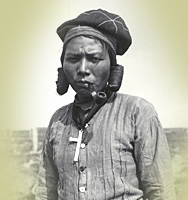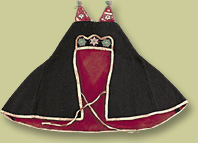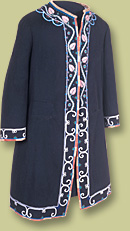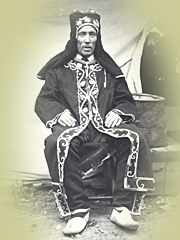 |
Arrival of Strangers - The Last 500 YearsBeliefsConversionSome Aboriginal people resisted Christian missions. Others welcomed them. Ultimately, Christianity competed with Aboriginal beliefs. Missionaries encouraged converts to put aside objects and ideas associated with Aboriginal belief, although some families kept them privately. Aboriginal beliefs covered all aspects of life, including the use of the land, the nature of human beings and animals, and the education of children. Christianity came to be practised everywhere, and the newcomers' settlements and new laws changed Aboriginal people's access to the land. These developments threatened the very foundations of Aboriginal cultures.
Membertou and Gabe Paul - Mi'kmaq Grand Chief Membertou was baptized, along with twenty members of his extended family, at Port Royale, on the feast of Saint John the Baptist, on June 24, 1610. Membertou received the name Henri after King Henri IV of France, who was designated godfather of the Mi'kmaq nation. Mi'kmaq and Maliseet men believed that by accepting baptism they would become French citizens, able to enjoy benefits, such as French wine and military dress. In its cut and style of decoration, Maliseet Chief Gabe Paul's coat reflects these beliefs.
Katri Tekakwitha and Peter Jones - Katri Tekakwitha (1656 - 1680), the daughter of a Christian Algonquin woman and a Mohawk traditionalist, was baptized at her own request when she was 20 years old. She spent her short life living with her people, following their way of life. Called the "Lily of the Mohawks," she was the first North American Aboriginal person to be named "venerable" by the Roman Catholic Church. Peter Jones (1802 - 1856) whose Aboriginal name was Kahkewwaquonaby (Sacred Feather), was an Ojibwa Methodist minister, author and translator. Highly successful as a preacher, Jones was a major influence among the Mississaugas of the Credit River, helping them adjust to the new way of life introduced by European settlers. | ||||



